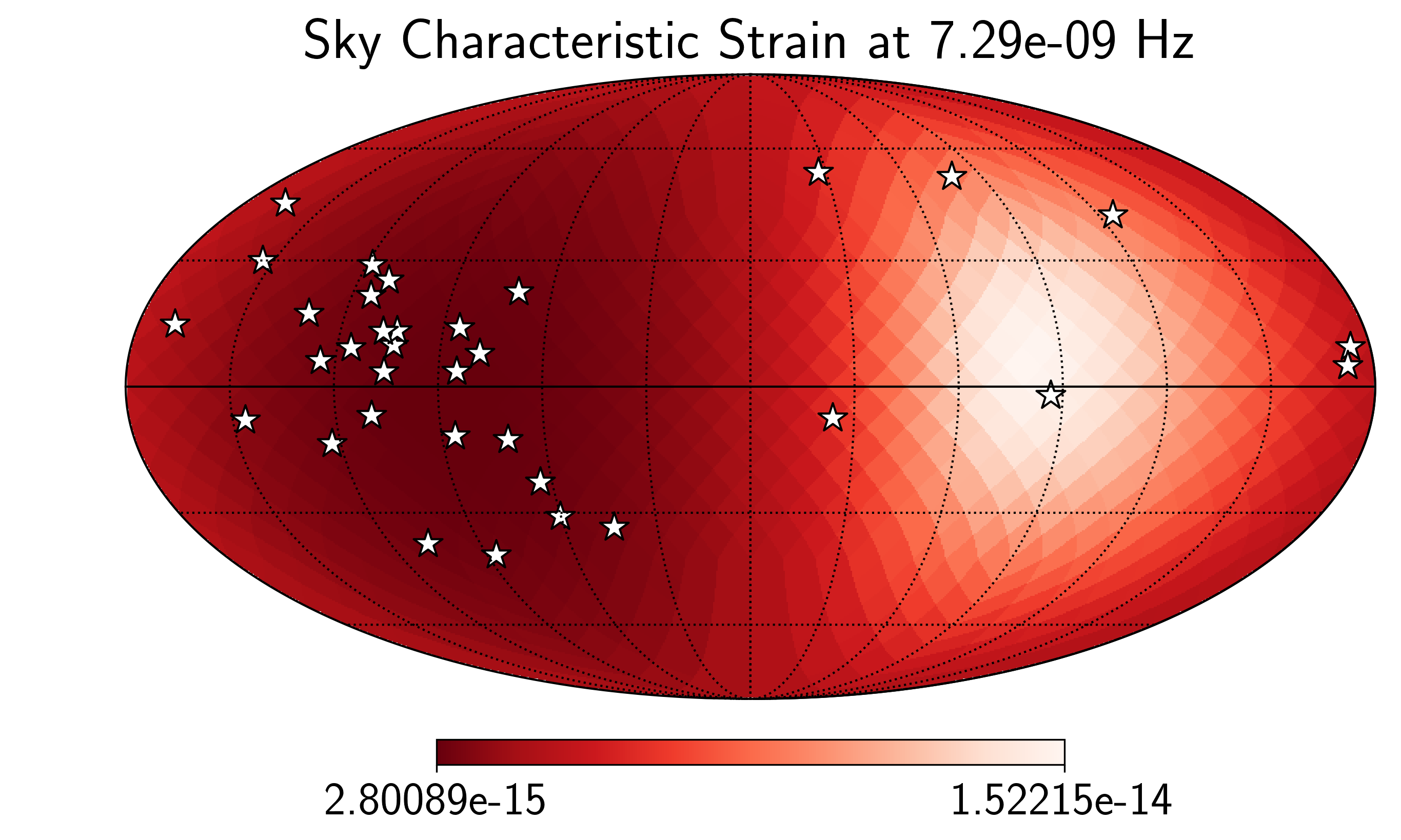Note
This tutorial was generated from a Jupyter notebook that can be downloaded here.
Real Pulsar Timing Array Data Tutorial¶
Here we present the details of using real par/tim files, as often
provided publicly by Pulsar Timing Array collaborations, to construct
senstivity curves. The hasasia code base deals with real data as
easily as simulated date. The most challenging part of the code will be
getting the data into a format compatible with hasasia.
First we import some important modules.
import numpy as np
import scipy.linalg as sl
import matplotlib.pyplot as plt
%matplotlib inline
import glob, pickle, json
import hasasia.sensitivity as hsen
import hasasia.sim as hsim
import hasasia.skymap as hsky
import matplotlib as mpl
mpl.rcParams['figure.dpi'] = 300
mpl.rcParams['figure.figsize'] = [5,3]
mpl.rcParams['text.usetex'] = True
Making hasasia.Pulsar objects with real data.¶
Here we use the Python-based pulsar timing data analysis package
enterprise. We choose this
software, as it has a Pulsar class well suited for dealing with the
needs of our code base. In particular the pulsar TOAs, errors, and sky
positions are handled cleanly. The sky positions are converted into
ecliptic longitude and co-latitude, which are the angles taken as input
by hasasia.
from enterprise.pulsar import Pulsar as ePulsar
The following paths point to the location of the data files (tim), parameter files (par) and noise files.
pardir = '/Users/hazboun/GoogleDrive/NANOGrav_Detection/data/nanograv/11yr_v2/'
timdir = '/Users/hazboun/GoogleDrive/NANOGrav_Detection/data/nanograv/11yr_v2/'
noise_dir = '/Users/hazboun/GoogleDrive/NANOGrav_Detection/11yr_stochastic_analysis'
noise_dir += '/nano11y_data/noisefiles/'
pars = sorted(glob.glob(pardir+'*.par'))
tims = sorted(glob.glob(timdir+'*.tim'))
noise_files = sorted(glob.glob(noise_dir+'*.json'))
Here we load the list of pulsars included in the NANOGrav 11-year analysis. This includes the pulsars in the dataset with longer than 3-year baselines.
psr_list = np.load('/Users/hazboun/GoogleDrive/NANOGrav_Detection/SlicedData/PSR_by_Obs_dict.npy')
psr_list = psr_list[-1]['psr_names']
def get_psrname(file,name_sep='_'):
return file.split('/')[-1].split(name_sep)[0]
pars = [f for f in pars if get_psrname(f) in psr_list]
tims = [f for f in tims if get_psrname(f) in psr_list]
noise_files = [f for f in noise_files if get_psrname(f) in psr_list]
len(pars), len(tims), len(noise_files)
(34, 34, 34)
Here we collate the noise parameters into one large dictionary.
noise = {}
for nf in noise_files:
with open(nf,'r') as fin:
noise.update(json.load(fin))
The following loop loads the pulsars into enterprise.pulsar.Pulsar
class instances. This uses a pulsar timing package in the background,
either Pint or TEMPO2 (via the Python wrapper libstempo).
Note that warnings about pulsar distances are usual and do not affect this analysis.
ePsrs = []
for par,tim in zip(pars,tims):
ePsr = ePulsar(par, tim, ephem='DE436')
ePsrs.append(ePsr)
print('\rPSR {0} complete'.format(ePsr.name),end='',flush=True)
PSR B1953+29 completeWARNING: Could not find pulsar distance for PSR J0023+0923. Setting value to 1 with 20% uncertainty.
PSR J0030+0451 completeWARNING: Could not find pulsar distance for PSR J0340+4130. Setting value to 1 with 20% uncertainty.
PSR J0613-0200 completeWARNING: Could not find pulsar distance for PSR J0645+5158. Setting value to 1 with 20% uncertainty.
PSR J1600-3053 completeWARNING: Could not find pulsar distance for PSR J1614-2230. Setting value to 1 with 20% uncertainty.
PSR J1713+0747 completeWARNING: Could not find pulsar distance for PSR J1738+0333. Setting value to 1 with 20% uncertainty.
PSR J1738+0333 completeWARNING: Could not find pulsar distance for PSR J1741+1351. Setting value to 1 with 20% uncertainty.
PSR J1744-1134 completeWARNING: Could not find pulsar distance for PSR J1747-4036. Setting value to 1 with 20% uncertainty.
PSR J1747-4036 completeWARNING: Could not find pulsar distance for PSR J1853+1303. Setting value to 1 with 20% uncertainty.
PSR J1853+1303 completeWARNING: Could not find pulsar distance for PSR J1903+0327. Setting value to 1 with 20% uncertainty.
PSR J1918-0642 completeWARNING: Could not find pulsar distance for PSR J1923+2515. Setting value to 1 with 20% uncertainty.
PSR J1923+2515 completeWARNING: Could not find pulsar distance for PSR J1944+0907. Setting value to 1 with 20% uncertainty.
PSR J1944+0907 completeWARNING: Could not find pulsar distance for PSR J2010-1323. Setting value to 1 with 20% uncertainty.
PSR J2010-1323 completeWARNING: Could not find pulsar distance for PSR J2017+0603. Setting value to 1 with 20% uncertainty.
PSR J2017+0603 completeWARNING: Could not find pulsar distance for PSR J2043+1711. Setting value to 1 with 20% uncertainty.
PSR J2145-0750 completeWARNING: Could not find pulsar distance for PSR J2214+3000. Setting value to 1 with 20% uncertainty.
PSR J2214+3000 completeWARNING: Could not find pulsar distance for PSR J2302+4442. Setting value to 1 with 20% uncertainty.
PSR J2317+1439 complete
Constructing the Correlation Matrix¶
The following function makes a correlation matrix using the NANOGrav noise model and the parameters furnished in the data analysis release. For a detailed treatment of the noise modeling see Lam, et al., 2015.
def make_corr(psr):
N = psr.toaerrs.size
corr = np.zeros((N,N))
_, _, fl, _, bi = hsen.quantize_fast(psr.toas,psr.toaerrs,
flags=psr.flags['f'],dt=1)
keys = [ky for ky in noise.keys() if psr.name in ky]
backends = np.unique(psr.flags['f'])
sigma_sqr = np.zeros(N)
ecorrs = np.zeros_like(fl,dtype=float)
for be in backends:
mask = np.where(psr.flags['f']==be)
key_ef = '{0}_{1}_{2}'.format(psr.name,be,'efac')
key_eq = '{0}_{1}_log10_{2}'.format(psr.name,be,'equad')
sigma_sqr[mask] = (noise[key_ef]**2 * (psr.toaerrs[mask]**2)
+ (10**noise[key_eq])**2)
mask_ec = np.where(fl==be)
key_ec = '{0}_{1}_log10_{2}'.format(psr.name,be,'ecorr')
ecorrs[mask_ec] = np.ones_like(mask_ec) * (10**noise[key_ec])
j = [ecorrs[ii]**2*np.ones((len(bucket),len(bucket)))
for ii, bucket in enumerate(bi)]
J = sl.block_diag(*j)
corr = np.diag(sigma_sqr) + J
return corr
Below we enter the red noise values from the NANOGrav 11-year data set release paper. These were the only pulsars in that paper that were deemed significant in that analysis.
rn_psrs = {'B1855+09':[10**-13.7707, 3.6081],
'B1937+21':[10**-13.2393, 2.46521],
'J0030+0451':[10**-14.0649, 4.15366],
'J0613-0200':[10**-13.1403, 1.24571],
'J1012+5307':[10**-12.6833, 0.975424],
'J1643-1224':[10**-12.245, 1.32361],
'J1713+0747':[10**-14.3746, 3.06793],
'J1747-4036':[10**-12.2165, 1.40842],
'J1903+0327':[10**-12.2461, 2.16108],
'J1909-3744':[10**-13.9429, 2.38219],
'J2145-0750':[10**-12.6893, 1.32307],
}
The following function retrieves the time span across the full set of pulsars.
Tspan = hsen.get_Tspan(ePsrs)
Set the frequency array across which to calculate the red noise and sensitivity curves.
fyr = 1/(365.25*24*3600)
freqs = np.logspace(np.log10(1/(5*Tspan)),np.log10(2e-7),600)
Constructing the Array¶
Here we instantiate hasasia.Pulsar class instances using those from
enterprise. The make_corr function constructs a noise
correlation matrix based on the noise model used by the NANOGrav
collaboration.
Note that the TOAs (and hence the TOA erros and design matrix) are
thinnned by a factor of ten. NANOGrav keeps many TOAs from a given
observation (often >50), which are not necessary to characterize the
sensitivity of the PTA. The differences in these TOAs would only be
needed to characterize frequencies much higher than investigated here.
Here we thin the TOAs because there are upwards of ~50 TOAs per
observing epoch in NANOGrav tim files and we don’t need all of these
to characterize the sensitivity we are interested in. If one has the
memory capabilities then the more data the better.
psrs = []
thin = 10
for ePsr in ePsrs:
corr = make_corr(ePsr)[::thin,::thin]
plaw = hsen.red_noise_powerlaw(A=9e-16, gamma=13/3., freqs=freqs)
if ePsr.name in rn_psrs.keys():
Amp, gam = rn_psrs[ePsr.name]
plaw += hsen.red_noise_powerlaw(A=Amp, gamma=gam, freqs=freqs)
corr += hsen.corr_from_psd(freqs=freqs, psd=plaw,
toas=ePsr.toas[::thin])
psr = hsen.Pulsar(toas=ePsr.toas[::thin],
toaerrs=ePsr.toaerrs[::thin],
phi=ePsr.phi,theta=ePsr.theta,
N=corr, designmatrix=ePsr.Mmat[::thin,:])
psr.name = ePsr.name
psrs.append(psr)
del ePsr
print('\rPSR {0} complete'.format(psr.name),end='',flush=True)
PSR J2317+1439 complete
The next step instantiates a hasasia.Spectrum class instance for
each pulsar. We also calculate the inverse-noie-weighted transmission
function, though this is not necessary.
specs = []
for p in psrs:
sp = hsen.Spectrum(p, freqs=freqs)
_ = sp.NcalInv
specs.append(sp)
print('\rPSR {0} complete'.format(p.name),end='',flush=True)
PSR J2317+1439 complete
Individual Pulsar Sensitivity Curves¶
Here we plot a sample of individual pulsar sensitivity curves.
fig=plt.figure(figsize=[15,45])
j = 1
names = ['B1937+21','J0340+4130','J1024-0719',
'J1713+0747','J1853+1303','J1909-3744',]
for sp,p in zip(specs,psrs):
if p.name in names:
fig.add_subplot(12,3,j)
a = sp.h_c[0]/2*1e-14
if p.name == 'J1024-0719':
alp = -5/2
a *= 8e-10
plt.loglog(sp.freqs[:150],a*(sp.freqs[:150])**(alp),
color='C2',label=r'$f^{-5/2}$')
else:
alp = -3/2
plt.loglog(sp.freqs[:150],a*(sp.freqs[:150])**(alp),
color='C1',label=r'$f^{-3/2}$')
plt.ylim(2e-15,2e-10)
plt.loglog(sp.freqs,sp.h_c, color='C0')
plt.rc('text', usetex=True)
plt.xlabel('Frequency [Hz]')
plt.ylabel('Characteristic Strain, $h_c$')
plt.legend(loc='upper left')
plt.title(p.name)
j+=1
fig.tight_layout()
plt.show()
plt.close()
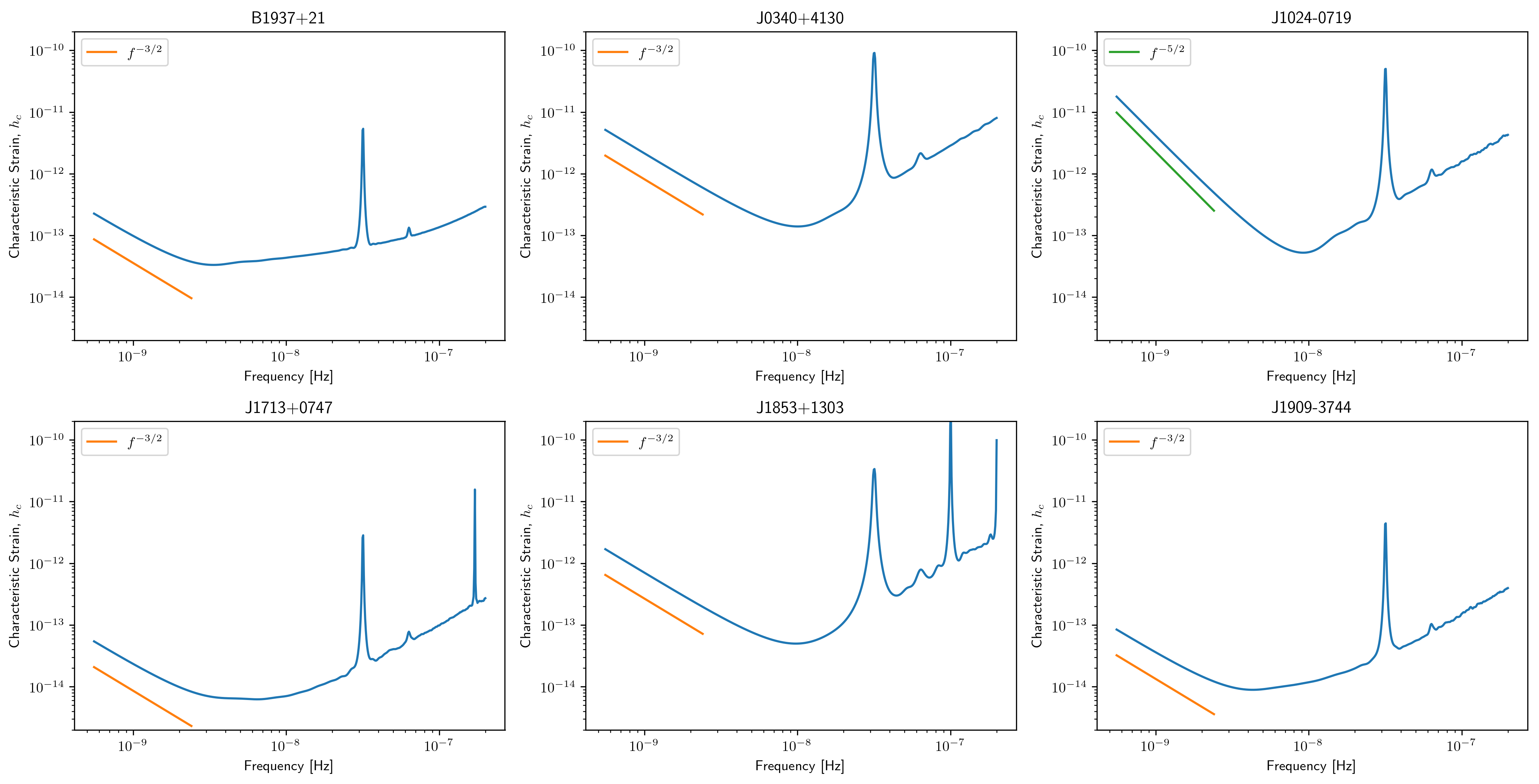
Below sensitivity curves of the full PTA are plotted, with a few pulsars highlighted.
names = ['J1713+0747','B1937+21','J1909-3744','J1024-0719']
for sp,p in zip(specs,psrs):
if p.name in names:
plt.loglog(sp.freqs,sp.h_c,lw=2,label=p.name)
else:
plt.loglog(sp.freqs,sp.h_c, color='k',lw=0.2)
plt.legend()
plt.show()
plt.close()
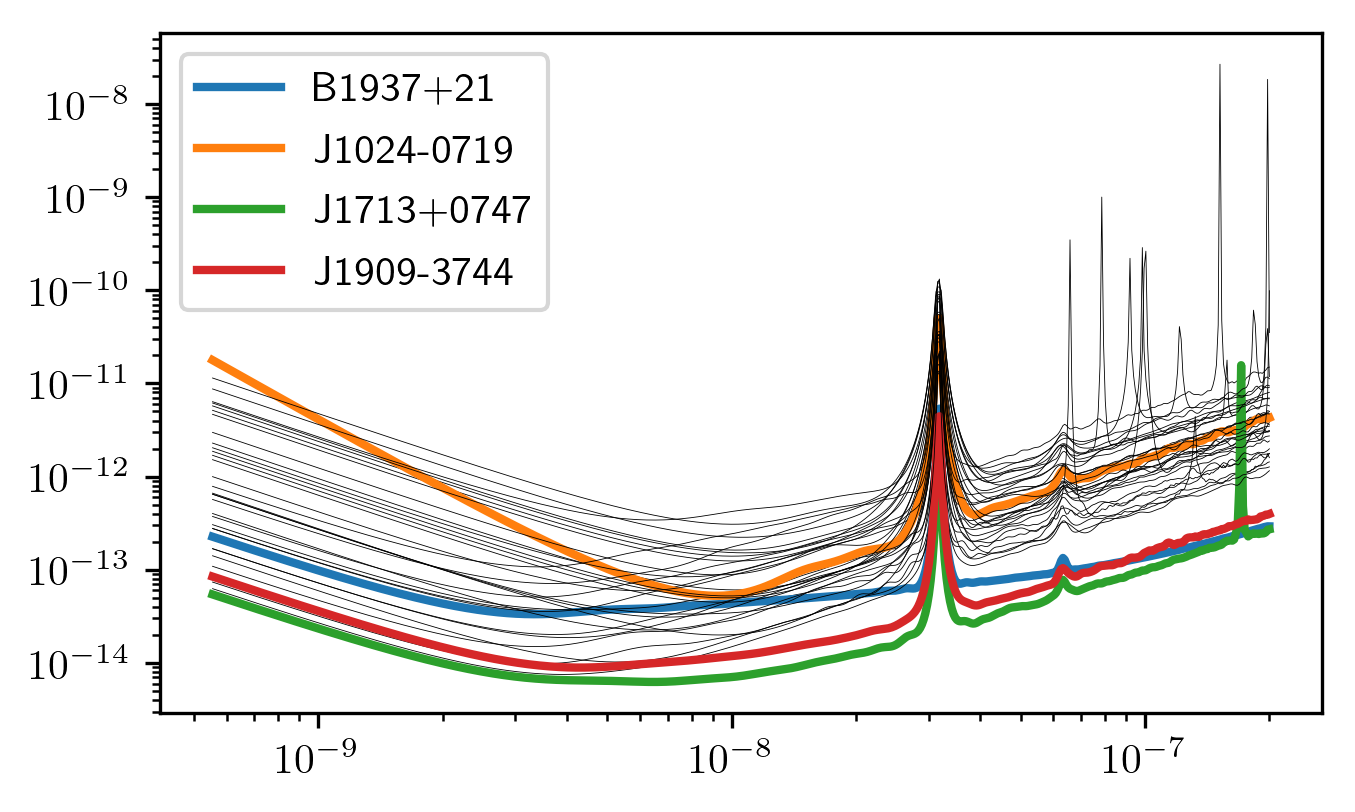
PTA Sensitivity Curves¶
Full PTA sensitivity curves are constructed by passing a list of
Spectrum instances to either the GWBSensitivity class or
DeterSensitivity class. See the Sensitivity Curve class for more
details.
ng11yr_sc = hsen.GWBSensitivityCurve(specs)
plt.loglog(ng11yr_sc.freqs,ng11yr_sc.h_c)
plt.xlabel('Frequency [Hz]')
plt.ylabel('Characteristic Strain, $h_c$')
plt.title('NANOGrav 11-year Data Set Sensitivity Curve')
plt.grid(which='both')
# plt.ylim(1e-15,9e-12)
plt.show()
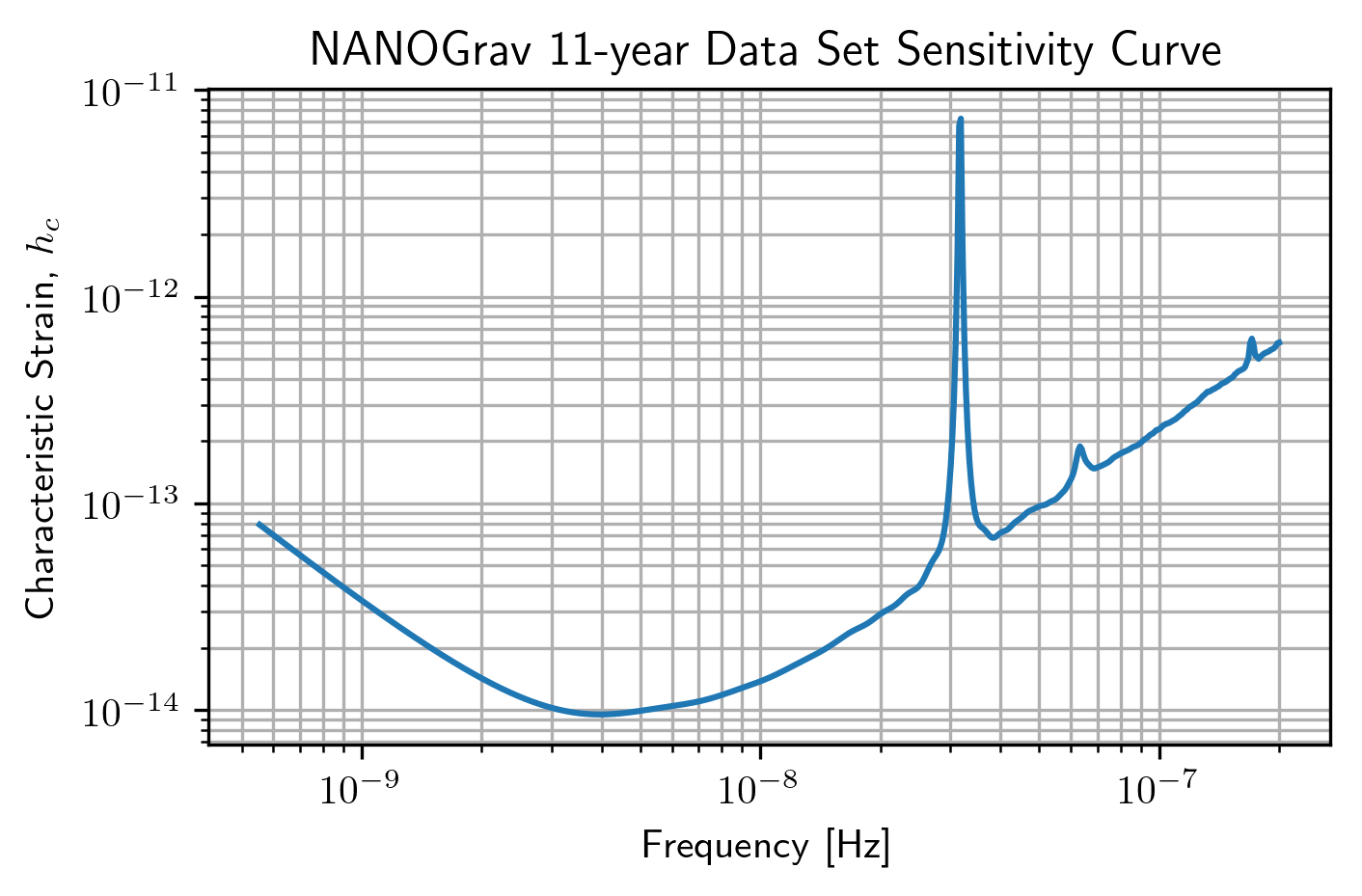
ng11yr_dsc = hsen.DeterSensitivityCurve(specs)
plt.loglog(ng11yr_dsc.freqs,ng11yr_dsc.h_c,label='Deterministic')
plt.loglog(ng11yr_sc.freqs,ng11yr_sc.h_c,label='Stochastic')
plt.xlabel('Frequency [Hz]')
plt.ylabel('Characteristic Strain, $h_c$')
plt.title('NANOGrav 11-year Data Set Sensitivity Curve')
plt.grid(which='both')
# plt.ylim(1e-15,9e-12)
plt.show()
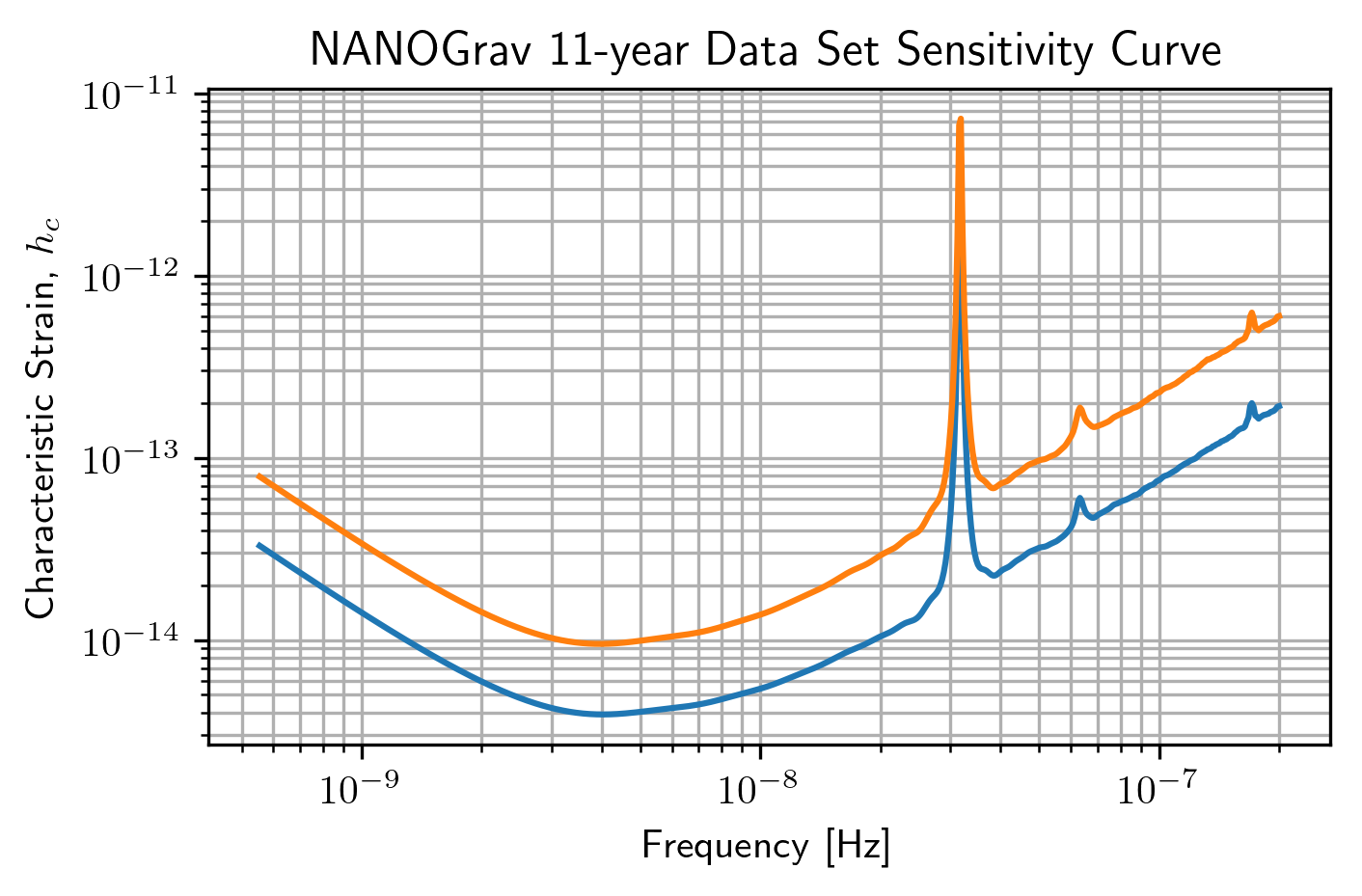
Power-Law Integrated Sensitivity Curves¶
The hasasia.sensitivity module also contains functionality for
calculating power-law integrated sensitivity curves. These can be used
to calculate the sensitivity to a power-law GWB with a specific spectral
or index, or an array of them.
#First for alpha=-2/3 (the default value).
SNR=1
hgw=hsen.Agwb_from_Seff_plaw(ng11yr_sc.freqs,
Tspan=Tspan,
SNR=SNR,
S_eff=ng11yr_sc.S_eff)
plaw_h = hgw*(ng11yr_sc.freqs/fyr)**(-2/3)
#And for an array of alpha values.
alpha = np.linspace(-7/4,5/4,30)
h=hsen.Agwb_from_Seff_plaw(freqs=ng11yr_sc.freqs,Tspan=Tspan,SNR=SNR,
S_eff=ng11yr_sc.S_eff,alpha=alpha)
plaw = np.dot((ng11yr_sc.freqs[:,np.newaxis]/fyr)**alpha,
h[:,np.newaxis]*np.eye(30))
for ii in range(len(h)):
plt.loglog(ng11yr_sc.freqs,plaw[:,ii],
color='gray',lw=0.5)
plt.loglog(ng11yr_sc.freqs,plaw_h,color='C1',lw=2,
label='SNR={0}, '.format(SNR)+r'$\alpha=-2/3$')
plt.loglog(ng11yr_sc.freqs,ng11yr_sc.h_c, label='NG 11yr Sensitivity')
plt.xlabel('Frequency [Hz]')
plt.ylabel('Characteristic Strain, $h_c$')
plt.axvline(fyr,linestyle=':')
plt.rc('text', usetex=True)
plt.title('NANOGrav 11-year Data Set\nPower-Law Interated Sensitivity Curve')
plt.ylim(hgw*0.75,2e-11)
plt.text(x=4e-8,y=3e-15,
s=r'$A_{\rm GWB}$='+'{0:1.2e}'.format(hgw),
bbox=dict(facecolor='white', alpha=0.6))
plt.legend(loc='upper left')
plt.show()
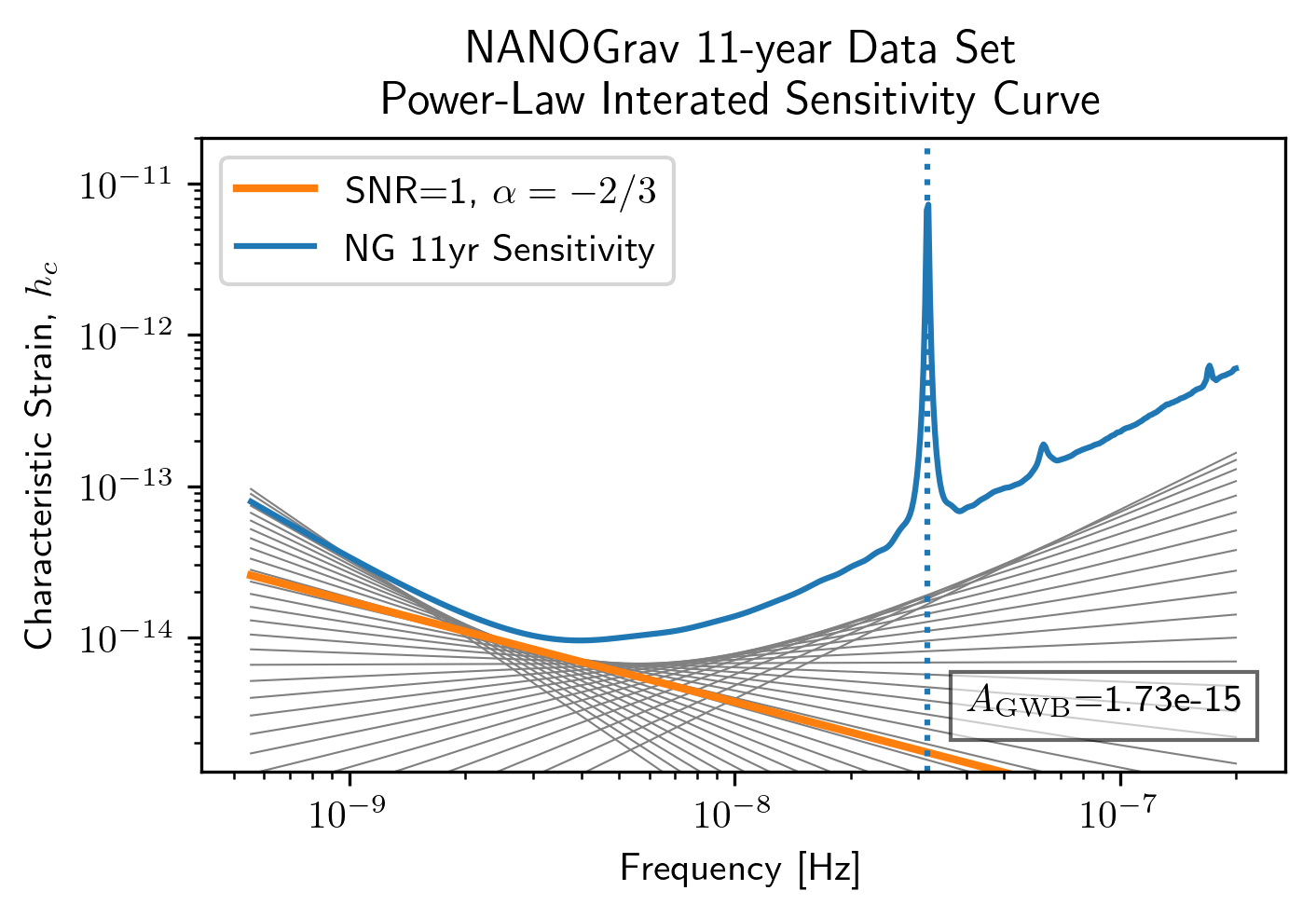
Hellings-Downs Curve¶
The sensitivity curve classes have all of the information needed to make a Hellings-Downs curve for the pulsar pairs in the PTA.
ThetaIJ,chiIJ,_,_=hsen.HellingsDownsCoeff(ng11yr_sc.phis,ng11yr_sc.thetas)
plt.plot(np.rad2deg(ThetaIJ),chiIJ,'x')
plt.title('Hellings-Downs Spatial Correlations')
plt.xlabel('Angular Separation')
plt.show()
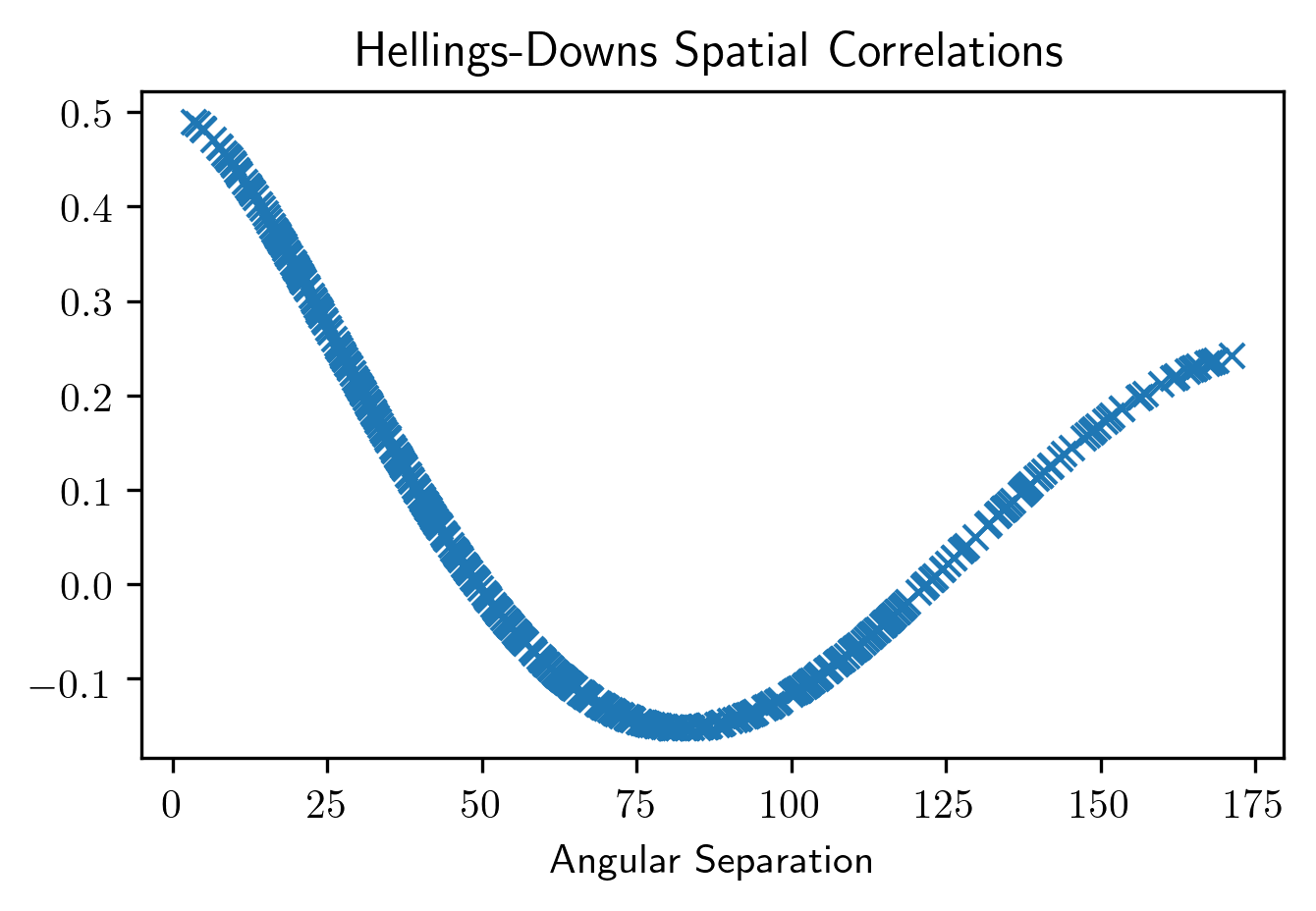
Pairwise Sensitivity Curves¶
The use can also access the pairwise sensitivity curves through the full
PTA GWBSensitivityCurve.
psr_names = [p.name for p in psrs]
fig=plt.figure(figsize=[5,3.5])
j = 0
col = ['C0','C1','C2','C3']
linestyle = ['-',':','--','-.']
for nn,(ii,jj) in enumerate(zip(ng11yr_sc.pairs[0],ng11yr_sc.pairs[1])):
pair = psr_names[ii], psr_names[jj]
if ('J1747-4036' in pair and 'J1903+0327' in pair):
lbl = '{0} and {1}'.format(psr_names[ii],psr_names[jj])
plt.loglog(ng11yr_sc.freqs,
np.sqrt(ng11yr_sc.S_effIJ[nn]*ng11yr_sc.freqs),
label=lbl,lw=2, color=col[j],linestyle=linestyle[j],
zorder=1)
j+=1
for nn,(ii,jj) in enumerate(zip(ng11yr_sc.pairs[0],ng11yr_sc.pairs[1])):
pair = psr_names[ii], psr_names[jj]
if ('J1713+0747' in pair and 'J1903+0327' in pair):
lbl = '{0} and {1}'.format(psr_names[ii],psr_names[jj])
plt.loglog(ng11yr_sc.freqs,
np.sqrt(ng11yr_sc.S_effIJ[nn]*ng11yr_sc.freqs),
label=lbl,lw=2, color=col[j],linestyle=linestyle[j],
zorder=2)
j+=1
for nn,(ii,jj) in enumerate(zip(ng11yr_sc.pairs[0],ng11yr_sc.pairs[1])):
pair = psr_names[ii], psr_names[jj]
if ('J1713+0747' in pair and 'J1909-3744' in pair):
lbl = '{0} and {1}'.format(psr_names[ii],psr_names[jj])
plt.loglog(ng11yr_sc.freqs,
np.sqrt(ng11yr_sc.S_effIJ[nn]*ng11yr_sc.freqs),
label=lbl,lw=2, color=col[j],linestyle=linestyle[j],
zorder=4)
j+=1
for nn,(ii,jj) in enumerate(zip(ng11yr_sc.pairs[0],ng11yr_sc.pairs[1])):
pair = psr_names[ii], psr_names[jj]
if ('J1713+0747' in pair and 'J1744-1134' in pair):
lbl = '{0} and {1}'.format(psr_names[ii],psr_names[jj])
plt.loglog(ng11yr_sc.freqs,
np.sqrt(ng11yr_sc.S_effIJ[nn]*ng11yr_sc.freqs),
label=lbl,lw=2, color=col[j],linestyle=linestyle[j],
zorder=3)
j+=1
plt.rc('text', usetex=True)
plt.xlabel('Frequency [Hz]')
plt.ylabel('$h_c$')
plt.ylim(9e-15,1e-9)
plt.legend(loc='upper left')
plt.grid()
# plt.rcParams.update({'font.size':11})
fig.suptitle('Pairwise Sensitivity Curves NG11yr',y=1.03)
fig.tight_layout()
plt.show()
plt.close()
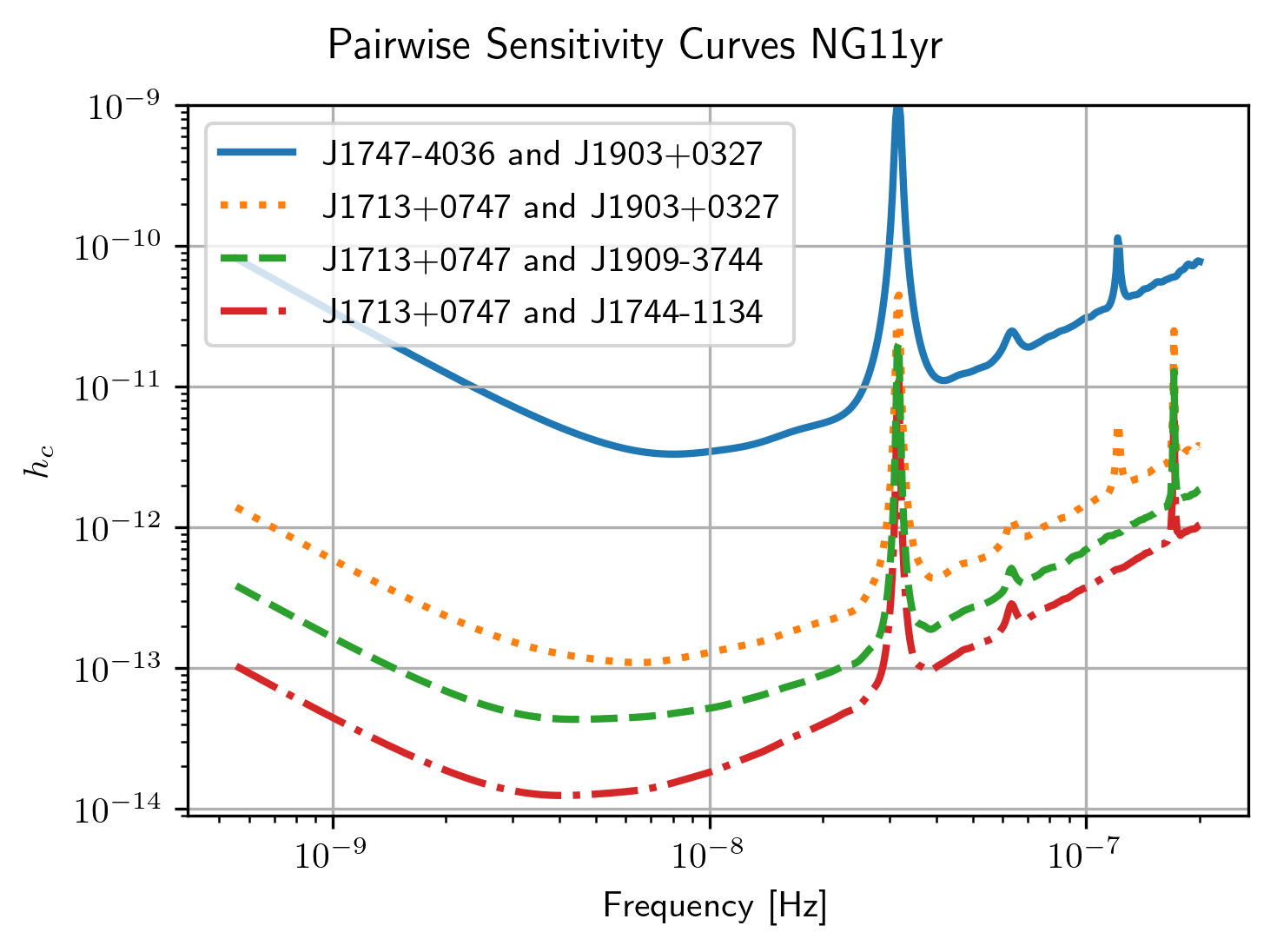
SkySensitivity with Real Data¶
Here we recap the SkySensitivity tutorial using the real NANOGrav data.
See the SkySenstivity tutorial for more details.
#healpy imports
import healpy as hp
import astropy.units as u
import astropy.constants as c
NSIDE = 8
NPIX = hp.nside2npix(NSIDE)
IPIX = np.arange(NPIX)
theta_gw, phi_gw = hp.pix2ang(nside=NSIDE,ipix=IPIX)
SM = hsky.SkySensitivity(specs,theta_gw, phi_gw)
min_idx = np.argmin(ng11yr_sc.S_eff)
idx = min_idx
hp.mollview(SM.S_effSky[idx],
title="Sky Sensitivity at {0:2.2e} Hz".format(SM.freqs[idx]),
cmap='Reds_r',rot=(180,0,0))
hp.visufunc.projscatter(SM.thetas,SM.phis,marker='*',
color='white',edgecolors='k',s=100)
hp.graticule()
plt.show()
0.0 180.0 -180.0 180.0
The interval between parallels is 30 deg -0.00'.
The interval between meridians is 30 deg -0.00'.

f0=8e-9
hcw = hsky.h_circ(1e9,120,f0,Tspan,SM.freqs).to('').value
SkySNR = SM.SNR(hcw)
plt.rc('text', usetex=True)
hp.mollview(SkySNR,rot=(180,0,0),#np.log10(1/SM.Sn[idx]),"SNR with Single Source"
cmap='viridis_r',cbar=None,title='')
hp.visufunc.projscatter(SM.thetas,SM.phis,marker='*',
color='white',edgecolors='k',s=200)
hp.graticule()
fig = plt.gcf()
ax = plt.gca()
image = ax.get_images()[0]
cmap = fig.colorbar(image, ax=ax,orientation='horizontal',shrink=0.8,pad=0.05)
plt.rcParams.update({'font.size':22,'text.usetex':True})
ax.set_title("SNR for Single Source")
plt.show()
0.0 180.0 -180.0 180.0
The interval between parallels is 30 deg -0.00'.
The interval between meridians is 30 deg -0.00'.
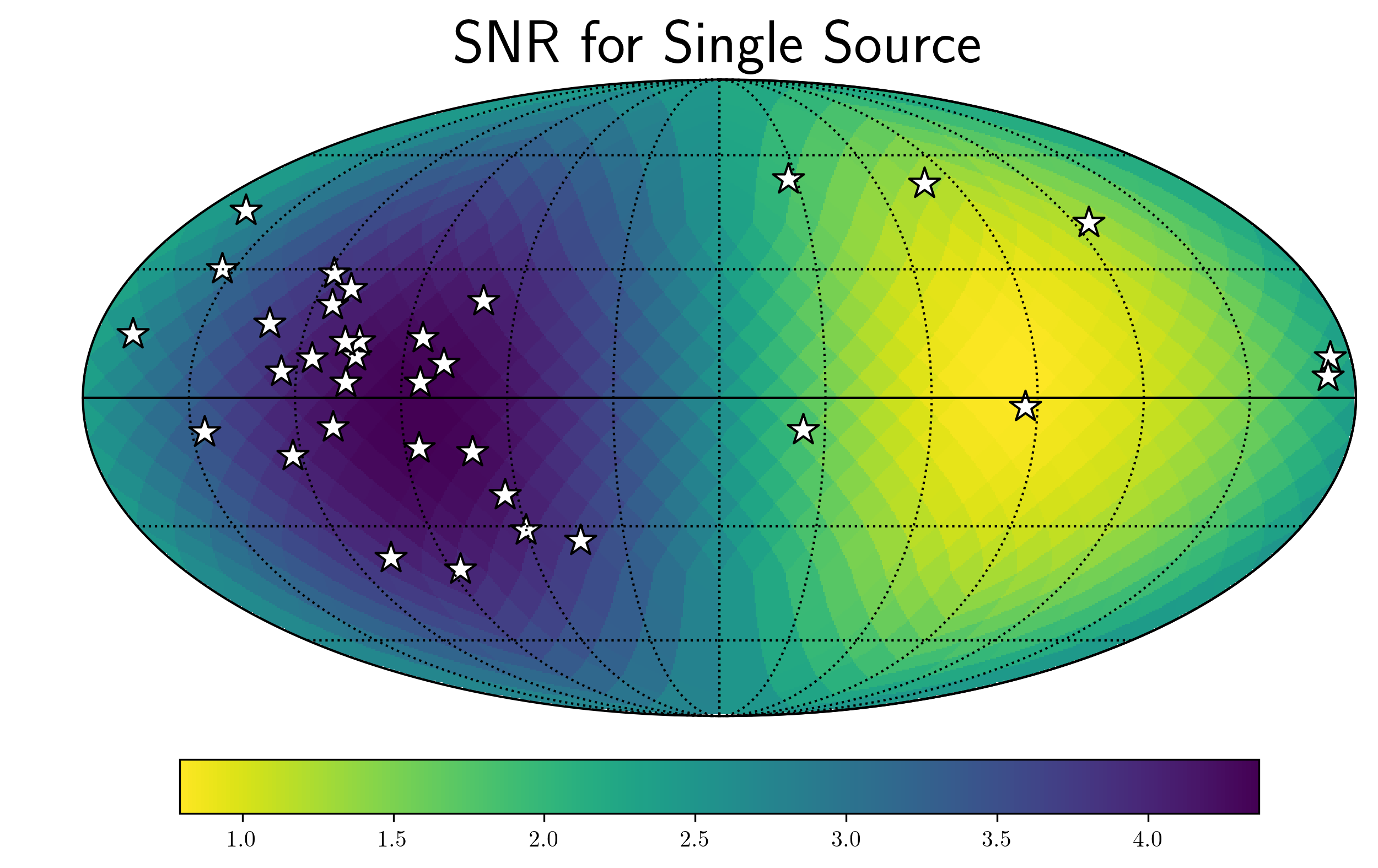
import matplotlib.ticker as ticker
hdivA= hcw / hsky.h0_circ(1e9,120,f0)
Agw = SM.A_gwb(hdivA).to('').value
idx = min_idx
hp.mollview(Agw,rot=(180,0,0),
title="",cbar=None,
cmap='viridis_r')
hp.visufunc.projscatter(SM.thetas,SM.phis,marker='*',
color='white',edgecolors='k',s=200)
hp.graticule()
#
fig = plt.gcf()
ax = plt.gca()
image = ax.get_images()[0]
cbar_ticks = [2.02e-15,1e-14]
plt.rcParams.update({'font.size':22,'text.usetex':True})
def fmt(x, pos):
a, b = '{:.1e}'.format(x).split('e')
b = int(b)
return r'${} \times 10^{{{}}}$'.format(a, b)
ax.set_title("Amplitude for Single-Source")
cmap = fig.colorbar(image, ax=ax,orientation='horizontal',
ticks=cbar_ticks,shrink=0.8,
format=ticker.FuncFormatter(fmt),pad=0.05)
plt.show()
0.0 180.0 -180.0 180.0
The interval between parallels is 30 deg -0.00'.
The interval between meridians is 30 deg -0.00'.

idx = min_idx
hp.mollview(SM.h_c[idx],
title="Sky Characteristic Strain at {0:2.2e} Hz".format(SM.freqs[idx]),
cmap='Reds_r',rot=(180,0,0))
hp.visufunc.projscatter(SM.thetas,SM.phis,marker='*',
color='white',edgecolors='k',s=200)
hp.graticule()
plt.show()
0.0 180.0 -180.0 180.0
The interval between parallels is 30 deg -0.00'.
The interval between meridians is 30 deg -0.00'.
